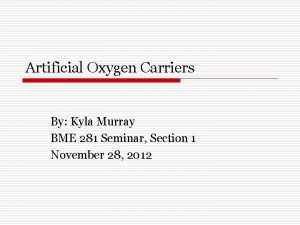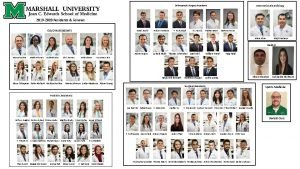Why Do Senior Residents Quit Kyla Terhune MD






















- Slides: 22

Why Do Senior Residents “Quit”? Kyla Terhune, MD

Disclosures �None financial. �I did not quit… but I fantasized about it. �I have rehearsed quitting as a junior attending more than as a resident. . .

Who are the Senior Residents? �Age 29 -32 �Generation X: Born 1961 -1981 Generations, Strauss and Howe, 1991 Reagan, Chernobyl, Space Shuttle, fall Berlin Wall Surgery Senior Residents: 1990 -2010 �Generation Y (Millennial): Born 1982 -2001 1993 Ad Age editorial Generations (Strauss and Howe), 1991 Surgery Senior Residents: 2011 -2031

What Characterizes? Generation X Generation Y � Individualistic � Technologically adept � Flexible � Value work/life balance � Tech Savvy � Family Centric � Team-Oriented � Attention-Craving � Supervising: Freedom and autonomy Hands-off Work Alone � Supervising: Structure Stability Immediate feedback/praise Frequent communication

Asking the Real Question… �Why quit when coming so far?

A National Study of Attrition in General Surgery Training: Which Residents Leave and Where Do They Go? �Yeo et al, 2010 (Yale), Annals of Surgery �ABS Resident Roster; 2007 -08 (n=6, 303) �Residency Coordinators asked: Why left Plans following �Linked to National Study of Expectations and Attitudes of Residents in Surgery, 2008 (n=3959) Demographic info (gender, marital, race, children)

Yeo, et al (Annals of Surgery, 2010)

Yeo, et al. 2010 � 188 (3%) resigned in 2007 -08 � 27 residents (0. 4%) had contract terminated � 63 (1%) transferred– not considered attrition �Attrition highest in internship and junior residency PGY-3: 1. 5% PGY-4: 0. 6% �Other demographic characteristics not sig.

Yeo, et al. 2010 � 75% stayed in medical training but switched to other fields 62% of those who left went on to nonsurgical fields 13% other surgical specialties � 10% left medical profession altogether

EVENT PERSONAL REFLECTION NON-RENEWAL

Demographical Data � 248 total programs � 166 programs contacted Those contacted had posted at least one position in the PGY 3 - PGY 4 position advertised � 50 (30%) programs responded �De-identified by program and year

Questions Asked �Did the position fill? �With whom did the position fill? �Was the position from expansion or attrition? �If attrition: Why the attrition? ▪ Personal choice or nonrenewal? Gender? Finish the academic year? Eventual placement?

Overall Number �Total approved for Match (236) �Total attrition (83 positions) � 3 positions per year (PGY 3 -5) � 10 years of data � 1. 2% chance of attrition per year in PGY 3 -5 Changeover in program directors

PERSONAL EVENT CHOICE REFLECTION NON-RENEWAL

Total = 116 positions PGY-3 (n = 60) PGY-4 (n = 51) Attrition 43 (71. 7%) 40 (78. 4%) Expansion 17 11

Total Attrition = 83 Attrition (n=82) Women Rate/ Position per Year 39 (47. 5%) 1. 7% Men 43 (52. 4%) 0. 6% 33% women: USMGs entering GS in years 2000 -2006 (Davis et al. JACS, 2011)

Demographical Data �PGY 3 – PGY 5 7080 total years of positions 1. 2% loss of positions to attrition per year 0. 4% expansion rate per year

Attrition by Size Attrition % per (n=83) Small 8 Medium 30 Large 45 P=0. 024 Year 2. 2% 1. 5% 0. 9% Expansion (n=29) 4 10 15 Bell et al. , 2009 Nrmp. org

Is it easier for Programs to Fill Based on Size? Filled Small Total (n=114) 9 Medium 43 38 (88. 4%) Large 59 48 (81. 4%) 8 (88. 9%) Not significant

Breakdown: Reasons of Attrition N=82 Personal Choice 58 (70. 7%) 48. 3% men Non-Renewal 23 (28. 0%) 60. 9% men Other 1

Where did they go? Total (N=67) General Surgery 21 (31. 3%) Surgical Specialty 12 (17. 9%) NOT Surgery 30 (44. 8%) Left Medicine 4 (5. 9%)

Why Do Senior Residents “Quit”? �Individual �Personal Choice: hypothesize events �Nonrenewal of Contract: earlier prediction?
 Kyla terhune
Kyla terhune Andreas carlsson bye bye bye
Andreas carlsson bye bye bye Trigonum suboccipitale
Trigonum suboccipitale Kyla.adair
Kyla.adair Kyla cunningham
Kyla cunningham While shopping kyla found a dress
While shopping kyla found a dress Kyla hines
Kyla hines Cedis centre de distribution
Cedis centre de distribution Kyla
Kyla Kyla murray
Kyla murray Quit game quiz
Quit game quiz The day the crayons quit summary
The day the crayons quit summary Quit yourselves like a man
Quit yourselves like a man Todd is trying to quit cheating
Todd is trying to quit cheating Can quit anytime i want
Can quit anytime i want Quit that shit
Quit that shit Macbeth famous line
Macbeth famous line Quit now maryland
Quit now maryland Pringud
Pringud Great wall of china golden ratio
Great wall of china golden ratio Impact of quit india movement
Impact of quit india movement Significance of quit india movement
Significance of quit india movement Quit salariale
Quit salariale









































